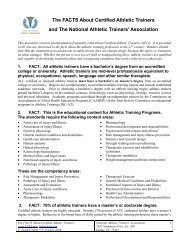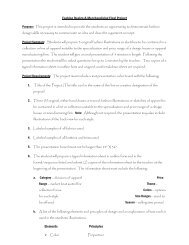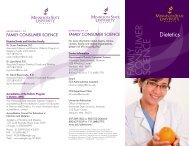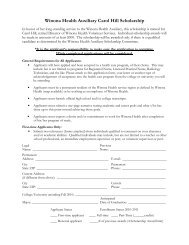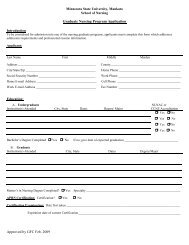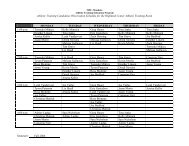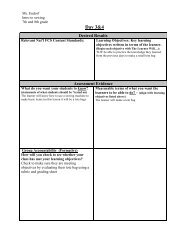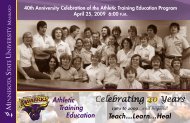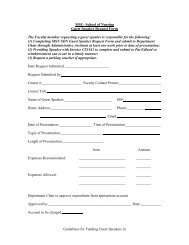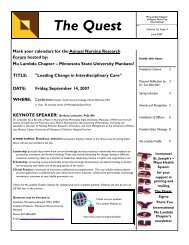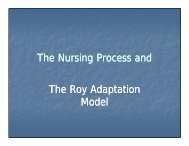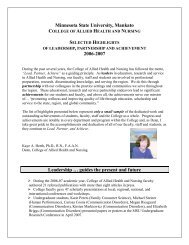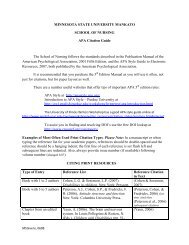Research Guidelines for Masters Thesis - Minnesota State ...
Research Guidelines for Masters Thesis - Minnesota State ...
Research Guidelines for Masters Thesis - Minnesota State ...
Create successful ePaper yourself
Turn your PDF publications into a flip-book with our unique Google optimized e-Paper software.
PROCESSES TO COMPLETE THESISIdentify the Problem, Draft a ProposalN604: Advanced Nursing <strong>Research</strong>, Select a <strong>Research</strong> AdvisorN604 provides students with a foundation <strong>for</strong> problem identification, literature review, questiondevelopment, and methods <strong>for</strong> conducting proposed projects. Additionally, faculty researchinterests are presented and research advisors are introduced to students. Students are assigned aresearch advisor based on their interest in participating in a faculty initiative, or the facultymembers interests in the student project. <strong>Research</strong> committees are decided upon by the faculty.A draft of the proposal <strong>for</strong> the thesis is completed in N604 under direction of the course faculty,with input from the research advisor. The purpose of a written proposal is to communicateresearch plans to others – <strong>for</strong> students this is the MSU research committee. There is nouniversally applicable or correct organizational <strong>for</strong>mat <strong>for</strong> proposals. Excellent discussions ofproposal content and detailed outlines <strong>for</strong> both quantitative and qualitative studies are presentedin the Burns and Grove research textbook and the APA manual.<strong>Thesis</strong> Proposal PreparationA thesis proposal must be approved be<strong>for</strong>e data collection is started. This proposal requiresacceptance and endorsement by the student’s examining committee. It is not required that thethesis proposal is approved by the College of Graduate Studies and <strong>Research</strong>.To facilitate the completion of the thesis, the student should prepare the proposal using APA<strong>for</strong>mat and the guidelines below. The following are the usual sections to be included in aresearch proposal. See Appendix C <strong>for</strong> <strong>for</strong>matting guidelines of the thesis.TITLE PAGE – The title should include all relevant variables, types of study, and sample.Please follow the Title Page Formatting Guide.ABSTRACT - The abstract provides a summary of your research. It is typically between 120 –250 words, but should not be more than 350 words. Items to include in the abstract are:Problem – in one sentence if possiblePurpose – state the same way as you do throughout your thesisDesignSettingSubjects/ParticipantsMeasuresResultsConclusions/ImplicationsYour abstract <strong>for</strong> your thesis proposal should include all the above elements except theresults and conclusions. Results and conclusions will be included when you havecompleted your research.2
CHAPTER I – INTRODUCTIONIntroduction to the Problem: The introduction tells the reader what is in the chapter. Youwill have an introduction to each chapter and the purpose is the same <strong>for</strong> each chapter - totell what is in the chapter and how it is organized.Problem <strong>State</strong>ment: The problem statement needs to include the general area of concern, abrief background about the concern, and the significance of the concern. A justification ofthe need is also included. The justification may indicate that there is a gap in theknowledge, conflicting findings, or omission of a group. You may see one of these phrasesat the end of the problem statement: Little is known about.… Findings of previous studies are conflicting…. Few studies of this patient population have been done….Tips <strong>for</strong> writing the problem statement follow: Keep it short, simple, and to the point. Use broad generalizations to set the stage <strong>for</strong> the specific problem - then give thespecifics. Present the argument or need <strong>for</strong> the study in your own words - use citations andquotes only to assist in making your point. Support the study with specific application-oriented examples. Clarify the population of interest <strong>for</strong> the study. Conclude with a concise synopsis of the primary problem of the study.Purpose of the Study: Burns and Grove (2009) define the research purpose as “a concisestatement of the specific goal or aim of the study.” You may see the following words usedinterchangeably: Purpose Goal Aim ObjectiveIn a thesis, the term “purpose” is generally used, but using any of the above terms would beacceptable. When you write proposals <strong>for</strong> entities other than MSU, the instructions <strong>for</strong> theproposal will in<strong>for</strong>m you which term to use.The purpose of the study is written in the past tense. Included in the purpose statement are: Type of study Variables (relationship if known to exist) Population SettingRemember the problem statement should support the purpose.3
<strong>Research</strong> Objectives, <strong>Research</strong> Questions, and/or Hypothesis: Please refer to Burns andGrove (2009) <strong>for</strong> the definitions of the above terms. This section may stand on its own ormay be a subsection of the purpose section of the proposal. Note that “and/or” was used asthe title of this section. You may be stating objectives, questions, hypothesis, or acombination <strong>for</strong> your proposal. Objectives can usually be reworded into an interrogativestatement to become a research question; there<strong>for</strong>e, the use of “objective” or “question” is amatter of preference. Descriptive and exploratory studies generally have objectives orquestions stated. Yet the statement of a hypothesis is dependent on the state of theknowledge as a hypothesis translates the purpose into a clear explanation or prediction ofthe expected results. You will see hypothesis used with comparative, correlational, andpredictive studies.Remember the purpose of the study needs to guide this section.When stating the objective, question, and/or hypothesis: Variables of the study need to be addressed List them in a logical order Do not include method Avoid the use of the term “significant” Use present tense.Definition of Terms: This section is a listing of the variables of the study along withconceptual and operational definitions. One approach is to list the variable followed by theconceptual definition and the operational definition.Summary: Each chapter concludes with a summary. You need to give the importantaspects of the chapter contents yet not all of the details. An example prototype of asummary <strong>for</strong> Chapter I follows:There are conflicting reports regarding……Thus, the purpose of this study wasto……Conceptual and operational definitions <strong>for</strong> the variables……were provided.CHAPTER II – REVIEW OF THE LITERATUREIntroduction: This chapter, as does every chapter, has an introduction section. This sectionprovides the reader with the organization of the chapter.Specific Section: The headings used in this section will be titled using the concepts andvariables of the study - NOT “SPECIFIC SECTION.” You may start with a review of thetheoretical literature on one or more concepts. Then the heading would be something like“Review of Theoretical Literature on …” This theoretical literature review can be capturedin other sections that address the specific concept(s), and depends on the literature andnature of the study’s purpose.As you review the purpose of the study, remember that each concept, variable, and/or topicneeds to be addressed in the literature review chapter.4
For example, if purposes of a study were to:Describe the prevalence of hypertension among nursing home residents and toexplore the association of hypertension and stress among nursing home residents.The headings you would have in CHAPTER II would probably be: Hypertension among Older Adults (and if enough literature is available you maybe able to narrow the heading to hypertension among nursing home residents). Stress among Older Adults (again this heading could be nursing home residents ifmore appropriate). Stress and Hypertension among Nursing Home Residents (or Older Adults ifmore appropriate).Remember: A table of the literature reviewed can be included in this chapter or as anAppendix. Provide a synthesis of the studies, not a paragraph on each study. Cite references according to current APA guidelines. Summarize the literature of each section.Conceptual Model or Theory: If a conceptual model or theory is used to guide the study, itneeds to be presented. How the study is guided by the theory or model needs to beincluded.Conceptual Map: Not all studies will have a conceptual model or theory. A conceptualmap based on the review of the literature is what guides the study. The map needs to bepresented along with an explanation of the map. The literature may address many variablesthat are beyond the purposes of the study, so you may find it helpful to bold the variablesthat are specific to the study.Summary: The summary will provide in<strong>for</strong>mation about the literature as well theconceptual model, theory, or conceptual map that guides the study.CHAPTER III – RESEARCH METHODOLOGYIntroduction: Review purpose of the study and tell reader the organization of the chapter.Design: Description of the research design (strengths and weaknesses, why selected).Primary Study: If the study you are conducting is using an established database or is asecondary data analysis study, you will want to describe the primary study or database.Sample: Identification of the population and sample (sample size, determination of samplesize, sampling criteria, sampling method).Setting: Selection of the setting, setting characteristics (can be combined with the samplesection).5
Ethical Considerations: Human subject consent.Instruments or Measurement: Description of instruments or measurements of each studyvariable (reliability, validity).Data Collection Procedure: Data collection process and schedule, management of data.Data Analysis: Description of plan <strong>for</strong> analysis of demographic data. Address eachresearch question/hypothesis – how will each be answered.Limitations: Description of method limitations if they have not been addressed in eachsection.Summary: One paragraph that summarizes the study methods.Complete the Proposal, Form a Committee, and Obtain CommitteeApproval <strong>for</strong> the <strong>Research</strong> ProjectN698 extends N604 content and is designed to support students as they refine the proposal.Completion of the proposal always requires a series of drafts and revisions. The following quote(Tornquist, 1987) reflects the iterative process involved in completing proposals:First you read and think, then you write, and as you write you think more. You also see theflaws in what you have already thought and written, so you go back to thinking. Then youwrite again, and because writing is discovery, you often find that you have ideas andquestions and even in<strong>for</strong>mation that you didn’t know you had. That leads you to new readingand further analyses and thus to new and different writing. So the process goes. (p. 5).When the proposal is ready <strong>for</strong> <strong>for</strong>mal review, the student (with input from the research advisorand research committee) will provide review and advice on the proposal and on all phases of theconduct of the project. Persons who are content experts but who do not have MSU GraduateFaculty Status may be invited to join the committee, but are considered ex-officio members. Ameeting is scheduled at which everyone sits down together to discuss the proposal. The overallpurpose of the proposal meeting is to strengthen the proposal through peer review. The usualresponsibilities <strong>for</strong> students, research advisors, and committee members include the following:6
Student Responsibilities Identify a date and time <strong>for</strong> a committee meeting at which the proposal will be discussedamong student(s) and committee members. Contact the MS in Nursing Program Administrative Assistant or Ruth Gregory at 7700France Avenue, Edina to arrange a room <strong>for</strong> the proposal meeting. In<strong>for</strong>mation that needs tobe provided is: date, time, committee chair and members, and title of proposal. Send a copy of the proposal to all committee members. Two weeks prior to the meeting iscustomary unless special arrangements have been made. Present a brief (< 15 minute) <strong>for</strong>mal overview of the proposed study at the committeemeeting, and then answer questions and provide clarification <strong>for</strong> committee members.Discuss with committee chair the <strong>for</strong>mat <strong>for</strong> the <strong>for</strong>mal presentation, usually a PowerPointpresentation is recommended.<strong>Thesis</strong> Advisor Responsibilities Work with the student throughout proposal development, project completion, and final oralexamination. Bring all <strong>for</strong>ms that need to be signed to committee meetings. The Graduate ProgramAdministrative Assistant usually prepares these at the time the student schedules thecommittee meeting (See Appendix A). Deliver signed <strong>for</strong>ms to the Graduate Nursing Program Administrative Assistant, who then<strong>for</strong>wards copies to the Graduate Office, the student(s), and the student's file(s). Review and approve Human Subjects Forms, return to student <strong>for</strong> submission to MSU humansubjects committee and clinical agencies, as needed (see “Human Subjects Approval”below).Committee Member Responsibilities Critically review the proposal. Decide to approve the proposal as is, approve the proposal with the understanding that thestudent will work with the research advisor to address written comments and concerns ofcommittee members, or not approve the proposal. If the proposal is not approved, the studentand research advisor will need to make significant changes and convene another committeemeeting. Following approval, all committee members must sign the <strong>for</strong>m “<strong>Research</strong> proposal –Committee Approval” (see Appendix A). Respond to questions raised by the <strong>Thesis</strong> Advisor and/or student chair regarding anychanges in the method presented in the proposal and as the study proceeds.Shared ResponsibilitiesStudents, advisors, and committee members all share responsibility <strong>for</strong> thoughtfulconsideration of the several factors that influence the scholarly nature of the research project.The following summary of issues presented by Locke, Spirduso, and Silverman (1993) is helpfulto review.7
The Topic Importance of the topic.What is the relevance of the topic to existing problems in practice? Have youestablished a clear relationship between existing in<strong>for</strong>mation and your proposedthesis? How will your project contribute to a line of inquiry or clinical practice? Scope of your proposed project.Is the proposed project reasonable in terms of time and resources? Advisement.Is someone with competence in the topic interested and available to advise theproject?The Scholarship Contribution to the field.Does the proposal contribute something that is different from or enhances previouswork? Perspective.Can you relate the topic to previous work and relevant existing knowledge? Logic.From title through procedures, is the central problem made explicit? Is the reasoningsupporting choices on methods and procedures made clear? Objectivity.Does the language used to write the proposal suggest a critical appraisal of evidencepresented in the literature review and other relevant knowledge bases? Are thestrengths and limitations of the proposal made clear? Preparation.Is the major relevant literature assimilated to the point of application to the proposedproject?The Presentation Mechanics.Is the proposal in 6 th edition APA <strong>for</strong>mat? Is the proposal proofread and well edited? Documentation.Is there adequate reference to materials <strong>for</strong> which credit is due? Are sourcesreferenced that are likely to be needed by interested and critical readers? Organization.Is there an easily understandable order of topics throughout the proposal? Are topicsseparated with appropriate headings and subheadings? Clarity.Is there enough detail provided so that someone else could carry out this project?8
INSTITUTIONAL REVIEW BOARD APPROVALIf a research project requires review by the MSU Institutional Review Board (IRB) and relevantclinical agency committees, this should be obtained after receiving research committee approvalof the thesis proposal and prior to beginning data collection. The purpose of such reviews is toexamine studies <strong>for</strong> compliance related to federal regulations concerned with the protection ofhuman subjects. Note that when human subjects are involved in a research proposal, the studentand advisor do not make the determination about the level of review required. This is theresponsibility of the MSU IRB and the clinical agency’s Institutional Review Board. BecauseMSU and clinical agencies have independent responsibilities related to the protection of humansubjects, students need to obtain review and approval from both organizations.Notification of the MSU IRB decision is sent to the research advisor and student. MSU HumanSubjects guidelines and procedures <strong>for</strong> review are available on the web and should be consultedby both students and advisors. The MSU website access <strong>for</strong> Institutional Review Board <strong>for</strong>ms is:http://grad.mnsu.edu/irb/Each clinical agency is likely to have additional and somewhat different expectations regardingstudent requests to conduct a research project within the agency. As with the MSU reviewprocess, the purpose is to protect human subjects. The student, in consultation with the researchadvisor, must contact the clinical agency, request directions on how to submit a request <strong>for</strong> IRBapproval, and obtain written permission from the agency to conduct the study in the specifiedfacility. Students will retain these permission notices.CONDUCT OF THE PROJECTN699 credits are taken to support work required to complete the thesis. These credits are used<strong>for</strong> registration while actively working with thesis advisor. The nature of work during this courseis negotiated between the student and the thesis advisor. The student should keep their thesisadvisor in<strong>for</strong>med of progress in completing the study throughout this time. This course may berepeated in the process of thesis completion. To register <strong>for</strong> the N699 <strong>Thesis</strong> credit(s) thestudent needs to contact the thesis advisor and receive special permission to register. The thesisadvisor will need our Tech ID to give you registration permission. Students must choose thePass/No credit grade option.A student registers <strong>for</strong> N699 Culminating Experience: <strong>Thesis</strong>, 1-4 thesis credits in a semester.Students in the CNS and FNP programs must complete three (3) thesis credits. Students in theNE program must complete four (4) thesis credits. The student must register <strong>for</strong> a minimum ofone credit of N699 in the final semester of the program.FORMAT OF FINAL THESIS PROPOSALThe thesis should be written using the past tense. See Appendix C <strong>for</strong> <strong>for</strong>matting guidelines ofthe thesis.TITLE9
APPROVAL OF THESIS – signed by Committee (see Appendix B)COPYRIGHT – optionalIRB APPROVAL COPYACKNOWLEDGEMENT – optional except if funding has been obtained. All funding shouldbe acknowledged.ABSTRACTTABLE OF CONTENTSLIST OF TABLESLIST OF FIGURESCHAPTER I – see proposal outlineCHAPTER II – see proposal outlineCHAPTER III – see proposal outlineCHAPTER IV – RESULTS OF ANALYSISIntroduction – Provide a short introduction to the chapter.Description of Sample – Describe the sample including those characteristics that areimportant <strong>for</strong> the study.Data Analysis - <strong>State</strong> each research question. Describe how the data were analyzed,followed by the results <strong>for</strong> each question. Tables and figures can be used to display thefindings. Tables and figures can be attached as Appendices. If this option is selected, thenarrative will reference the location (see Appendix). A discussion of the results is NOTusually included in this chapter, rather is presented in CHAPTER V.SummaryCHAPTER V – DISCUSSION AND CONCLUSIONSThe faculty suggest that CHAPTER V be organized as a manuscript. It is recommended thatprior to writing this chapter, potential journals <strong>for</strong> submission are reviewed. The chapter’sorganization should follow that of a manuscript <strong>for</strong> the journal found to be most appropriate.(NOTE: If you are not going to publish your thesis results, please see below regarding whatshould be included in CHAPTER V.) The sections of this chapter, if submitting <strong>for</strong> publication,will probably include:10
Introduction: Includes purpose and research questions/hypothesisBackground Literature: Summary of CHAPTER IIMethod: Summary of CHAPTER III; subheadings may include subjects, instruments,procedureResults: Summary of CHAPTER IV with the possible inclusion of several tablesDiscussion and Conclusions: <strong>Research</strong> questions should be stated. Findings need to besummarized, discussed, and related back to the literature. Discuss what happened, whatwas expected or unexpected, and why. Form some conclusions. This is the place tospeculate on what your findings mean. After all the research questions are discussed, thefindings should be compared to the conceptual map/model <strong>for</strong> congruency. If thefindings do not support the concept map/model, then a new concept map/model should beincluded.Scope and LimitationsImplications <strong>for</strong> PracticeImplications <strong>for</strong> <strong>Research</strong>SummaryIf you are planning on not publishing your thesis, you may follow the guidelines above or theguidelines provided below.Introduction: Includes purpose and what is contained within the chapter.Description of the Sample: Describe your sample and relate your sample to what youfound in the literature.Discussion and Conclusions: <strong>Research</strong> questions should be stated. Findings need to besummarized, discussed, and related back to the literature. Discuss what happened, whatwas expected or unexpected, and why. Form some conclusions. This is the place tospeculate on what your findings mean.Concept Map: After all the research questions are discussed, the findings should becompared to the conceptual map/model <strong>for</strong> congruency. If the findings do not supportthe concept map/model, then a new concept map/model should be included.Scope and LimitationsImplications <strong>for</strong> PracticeImplications <strong>for</strong> <strong>Research</strong>11
SummaryREFERENCES – follow APA <strong>for</strong>matAPPENDICESORAL EXAMINATION OF THE THESISN699 <strong>Thesis</strong> is the course the student registers <strong>for</strong> the semester the student is ready to make a<strong>for</strong>mal presentation of the completed project to the research committee and invited guests.(Completed research projects are often of interest to other students, faculty, and communitymembers, and guests may be invited to attend at the discretion of the thesis advisor and student.)While students determine with their thesis advisor how the meeting will be structured, the overallpurpose is to provide an opportunity <strong>for</strong> students, committee members, and guests to discuss theresearch in terms of its scientific merit, its contribution to nursing knowledge, and itsimplications <strong>for</strong> further research and activities. The usual responsibilities <strong>for</strong> students, researchadvisors, and committee member’s parallel responsibilities associated with the proposalapproval:Student Responsibilities Identify a date and time when all committee members can attend. Notify the MS in Nursing Program Administrative Assistant, Beth Teigen, or Ruth Gregor at7700 France at least 3 weeks in advance of the presentation in order to assure (a) roomscheduling is completed, (b) posting of the date, time, and one paragraph abstract iscompleted, and (c) relevant paperwork is generated in a timely fashion (see Appendix B). Send a copy of the completed thesis, along with a written memo verifying the time, date, andplace of the meeting, to committee members. Two weeks prior to the meeting is customaryunless special arrangements have been made. Present a brief (< 15 minute) <strong>for</strong>mal overview of the study at the committee meeting, andthen answer questions and provide clarification <strong>for</strong> committee members. Discuss withcommittee chair the <strong>for</strong>mat <strong>for</strong> the <strong>for</strong>mal presentation.<strong>Thesis</strong> Advisor Responsibilities Work with the student throughout the thesis development, project completion, andpreparation <strong>for</strong> the final oral examination. Bring all <strong>for</strong>ms that need to be signed to committee meetings. The MS in Nursing ProgramAdministrative Assistant usually prepares these at the time the student schedules thecommittee meeting (see Appendix B). Deliver signed <strong>for</strong>ms to the MS in Nursing Program Administrative Assistant, who then<strong>for</strong>wards copies to the Graduate Office, the student(s), and the student’s file(s).Committee Member Responsibilities Determine whether the completed project satisfactorily meets MSU Master’s in NursingProgram expectations around research competencies. If the research project is found to besatisfactory, students receive a final grade <strong>for</strong> N699. If the thesis is found to be12
unsatisfactory, written recommendations are given to the student and the presentation isrescheduled within a stipulated time span.CRITERION FOR GRADE EARNED FOR THESISCriteriaThe grade earned <strong>for</strong> the N699 credit will reflect the final outcome as well as the process towardthe outcome. Each of the areas below will be addressed by the consistency (e.g., always, usually,sometimes, infrequently, and rarely) and quality (e.g., superior, excellent, good, and poor)expected of a graduate student.Structure Writing style Use of APA Concepts flow in an organized mannerProcess Communication with committee chair Communication with committee members Communication with the MS Program Administrative AssistantOutcome Demonstrates synthesis of the literature Integrates literature into the discussion of findings Demonstrates understanding of the research processGrade DeterminationThe students will be asked to leave the room <strong>for</strong> a short period of time at the completion of thedefense. The Committee will decide if the thesis/professional study was defended satisfactorilyand will discuss proposed grade <strong>for</strong> the course. The student will be in<strong>for</strong>med of pass/no passstatus of the thesis at the completion of the defense. A final grade will be submitted by the chairwhen the bindery <strong>for</strong>m has been completed.DISPOSITION OF THE RESEARCH PROJECTFollowing a satisfactory oral presentation/examination, the student and the advisor will worktogether to make any needed revisions. For the thesis option, the advisor must sign off on the<strong>for</strong>m “<strong>Thesis</strong> Completion Certificate” be<strong>for</strong>e the student takes the final product to be bound (seeAppendix B).Paper Specifications and PrintingAll copies of the paper must be printed with a laser printer on opaque, white, 20# or 24# paper ofat least 25% cotton content and with a visible watermark. indicating the required paper quality..13
The original printed copy may be reproduced or photocopied by other processes if copies arelegible, permanent, and on the same kind of paper as the original copy. Copies on standardcopier paper will NOT be accepted.The paper must be submitted unbound with no punch holes or other mutilations. No correctionswith pen or pencil are acceptable.The original and three copies of the thesis (printed on the type of paper noted above) must besubmitted by the due date <strong>for</strong> the semester the student plans to graduate. Please consult theCollege of Graduate Studies web page <strong>for</strong> thesis without exception due dates.Submission of Final PaperFollowing the appropriate examinations and approval of the examining committee, at least anoriginal and three copies of the thesis are to be delivered to the College of Graduate Studiesoffice <strong>for</strong> their review and binding. Check with the Graduate Office <strong>for</strong> current binding fee costsand deadlines <strong>for</strong> submitting papers to their office. The payment <strong>for</strong> binding shall accompanythe copies when they are submitted to the Graduate Office.All papers are reviewed by the College of Graduate Studies staff where the manuscript ischecked to make sure that margins, paper, typing, printing, and neatness meet Universityrequirements and that all the Graduate College rules and procedures have been followed. Visualquality must meet acceptable standards. It is the students responsibility to carefully proofreadand examine all copies of the paper be<strong>for</strong>e submitting it to the Graduate Office. All submittedmaterials must meet the approved manual of style <strong>for</strong> the student’s program. After the examiningcommittee has approved the paper and signed the endorsement/acceptance page, and theGraduate Office staff has ascertained all requirements have been met, the paper will be acceptedand approved by the Graduate Dean.Binding and Distribution of CopiesBinding is arranged by the College of Graduate Studies after Committee Approval. The Collegeof Graduate Studies will distribute copies as follows: 1) one copy to the University library, 2)one copy to the University archives, 3) one copy to the thesis advisor, and 4) one copy to bepicked up by the student or mailed to the address listed on the Application <strong>for</strong> Graduation. TheCollege of Graduate Studies cannot be responsible <strong>for</strong> papers that are lost in the mail or ifthe address provided is not correct. In order to avoid mailing problems, you may provide aself-addressed mailing label when you submit your final paper. Please notify the College ofGraduate Studies if you prefer to pick up your final bound copy rather than having it mailed.Each thesis is bound in maroon. Examples of previously approved theses are available on theshelves in the University Library.Students are also encouraged to submit an abstract of their thesis to University Microfilms at theUniversity of Michigan. University Microfilms will publish an abstract (150 words or less) of14
your thesis in a quarterly publication <strong>Masters</strong> Abstracts International and prepare a masternegative microfilm of your thesis. Complete in<strong>for</strong>mation about this service is available from 1-800-521-0600, extension 430 or 431.REFERENCESAmerican Association of Colleges of Nursing. (March 13, 2006). Position statement on nursingresearch. Retrieved from http://www.aacn.nche.edu/Publications/positions/NsgRes.htmAmerican Psychological Association.. (2010). Publication manual of the AmericanPsychological Association (6 th ed.). Washington, DC: Author.Burns, N., & Grove, S.K. (2009). The practice of nursing research: Appraisal, synthesis, andgeneration of evidence (6 th ed.). St. Louis: Elsevier Saunders.Locke, L.F., Spirduso, W.W., & Silverman, S. J. (1993). Proposals that work (3 rd ed.). NewburyPark, CA: Sage Publications.Tornquist, E.M. (1986). From proposal to publication. Menlo Park, CA: Addison-WesleyPublishing Company.15
APPENDIX AForms Related to Proposal(These <strong>for</strong>ms are completed by the MS Program Administrative Assistant)1. Proposal Meeting MemoStudents provide meeting date, time, title of the thesis proposal, name of committee chair,and committee members to the MS Program Administrative Assistant 3 weeks prior tothe meeting. If PowerPoint capabilities and/or ITV, conference calling, or other mediaare needed, the MS Program Administrative Assistant should be notified at this time.MS Program Administrative Assistant will secure a room and will send this notificationto the student(s) and committee members via e-mail.2. <strong>Research</strong> Proposal/Committee Approval FormMS Program Administrative Assistant will provide this <strong>for</strong>m to the thesis chair.Committee members will sign this <strong>for</strong>m when the thesis proposal is approved.<strong>Thesis</strong> chair will give signed <strong>for</strong>m to the MS Program Administrative Assistant.16
<strong>Minnesota</strong> <strong>State</strong> University MankatoPROPOSAL MEETINGTo:From:Date:RE:<strong>Research</strong> Proposal<strong>Thesis</strong>A <strong>Research</strong> Proposal/Committee Meeting <strong>for</strong> ______________’s research project entitled:has been scheduled <strong>for</strong>:Date:Time:Room:17
<strong>Minnesota</strong> <strong>State</strong> University MankatoRESEARCH PROPOSAL/COMMITTEE APPROVAL FORMTO:Sue Ellen Bell, PhD, PHCNS, BCCoordinator, Master’s Programs in NursingFROM:RE:FACULTY ENDORSEMENT and REVIEW COMMITTEEDATE:The following have agreed to serve on my research committee:<strong>Thesis</strong> Advisor Signature:______________________________________________________Committee MemberSignature:______________________________________________________Committee MemberSignature:______________________________________________________Please indicate where these persons may be reached, if participants are not School of Nursingfaculty.RESEARCH PROJECT TITLE:INDICATE OPTION:<strong>Thesis</strong>Final Approval by Committee on:Committee Chairperson_________________________________________ ___/___/___(Signature)(Date)1 - Graduate Office1 - Student18
1 - Student File19
APPENDIX BForms Related to Completed Project(These <strong>for</strong>ms are completed by the MS Program Administrative Assistant)1. Examination Notice – MemoStudents provide meeting date, time, title of the thesis, an electronic copy of theirabstract, name of thesis advisor, and committee members to the MS ProgramAdministrative Assistant 3 weeks prior to the meeting. The MS ProgramAdministrative Assistant should be notified at this time of the need <strong>for</strong>PowerPoint capabilities and other electronic media or conference callingcapabilities are necessary.The MS Program Administrative Assistant will secure a room and will send thisnotification to the student and committee members via e-mail.2. Notice of <strong>Research</strong> Project PresentationThe MS Program Administrative Assistant will complete this <strong>for</strong>m and send to thestudent and committee members via e-mail.3. Completed <strong>Research</strong> Project Approval FormMS Program Administrative Assistant will provide this <strong>for</strong>m to the thesis advisor.Committee members will sign this <strong>for</strong>m when thesis defense is completedsatisfactorily.The student will be given the signed <strong>for</strong>m(s) by their thesis advisor after edits arecompleted and upon approval of the final thesis.4. <strong>Research</strong> Project Completion CertificateThe MS Program Administrative Assistant will provide the necessary <strong>for</strong>ms to thethesis advisor.The thesis advisor will give the <strong>for</strong>ms to the student(s) after all edits arecompleted and final approval is given <strong>for</strong> the thesis.Students will return the completed <strong>for</strong>ms to the MS Program AdministrativeAssistant.20
ORAL EXAMINATION NOTICETO:FROM:DATE:RE:<strong>Research</strong> Project Oral ExaminationA <strong>Research</strong> Project Oral Examination/Committee Meeting <strong>for</strong> ______________’s research projectentitled:has been scheduled <strong>for</strong>:Date:Time:Room:NOTE: Please check with the student to determine if s/he has an IP grade <strong>for</strong> <strong>Thesis</strong> (N699). If so, makearrangements to turn in a change of grade <strong>for</strong>m.22
SCHOOL OF NURSING* * * * * * * * * * * * * * * * * * * * * * * * * * * * * * * * * * * * * * * * * * * * * * * *Notice of <strong>Research</strong> Project Presentation(Student Name)TITLE:PLACE:DATE:TIME:RESEARCH COMMITTEE:<strong>Thesis</strong>ABSTRACT:* * * * * * * * * * * * * * * * * * * * * * * * * * * * * * * * * * * * * * * * * * * * * * * *Committee– 3Student– 1Posting– 123
<strong>Minnesota</strong> <strong>State</strong> University MankatoCOMPLETED RESEARCH PROJECT APPROVAL FORMTO:Sue Ellen Bell, PhD, PHCNS, BCCoordinator, Master’s Programs in NursingFROM:RE:FACULTY ENDORSEMENT and FINAL REVIEW COMMITTEEDATE:RESEARCH PROJECT TITLE:INDICATE OPTION: <strong>Thesis</strong> Professional StudyRESEARCH COMMITTEE:<strong>Thesis</strong> Advisor Signature:______________________________________________________Committee MemberSignature:______________________________________________________Committee MemberSignature:______________________________________________________Date of Final approval by Committee:1 - Graduate Office1 - Student File24
<strong>Minnesota</strong> <strong>State</strong> University MankatoTHESIS PROJECT COMPLETION CERTIFICATE__________________’s research project has been accepted as being in final approved <strong>for</strong>m.<strong>Thesis</strong> Advisor’s signature/Date<strong>Thesis</strong> option:_____________________ has/have deposited an original and three copies of the thesis at<strong>for</strong> binding.Bound copies will be paid <strong>for</strong> at the time of drop off or when they are picked up.SignedDateReturn completed <strong>for</strong>m to:Graduate Nursing Office360 Wissink HallMankato, MN 56001Graduate Office - 1Chair - 1Student - 1File- 125
APPENDIX C<strong>Thesis</strong> Formatting <strong>Guidelines</strong>1. Title Page Format2. Signature Page Format3. Table of Contents4. Examples of Headings or Divisions of Text5. Example of Tables and Figures6. Guideline <strong>for</strong> Final <strong>Thesis</strong> Formatting7. Checklist <strong>for</strong> <strong>Thesis</strong> Students26
TITLE PAGE FORMATTITLEA thesis submitted InPartial Fulfillment of the Requirements<strong>for</strong> the Degree ofMaster of Scienceat <strong>Minnesota</strong> <strong>State</strong> University, Mankatoby(Student)(Student)Consider whether you wantto use your middle initial.DateMonth and year of yourgraduation.27
Copyright2010Mary P. Jones28
Signature Page FormatAll papers must include a title page and an endorsement (signature) page. The title page of analternate plan paper or thesis shall contain the following in<strong>for</strong>mation: complete statement of title,students name, identifying legend (“A thesis submitted in partial fulfillment of the requirements<strong>for</strong> the degree of [Master of Arts/Science] at <strong>Minnesota</strong> <strong>State</strong> University, Mankato”), location ofthe University, and month and year of graduation.Each copy of the final paper shall contain immediately after the title page an endorsement/acceptance page bearing the date of the approval and signatures of the members of the student’sexamining committee. The names of the faculty members shall be printed below their signaturelines.29
TABLE OF CONTENTSPageLIST OF TABLES……………………………………………………………….…..LIST OF FIGURES……………………………………………………………….…viviiCHAPTERI. INTRODUCTION.……………………………………………………. 1Introduction to the Problem……………………………………….…..Problem <strong>State</strong>ment…………………………………………………….Purpose of the Study…………...….…………………………………..<strong>Research</strong> Questions……………………………………………………Definitions of Terms…………………………………………………..Assumptions…………………………………………………………...Limitations…………………………………………………………….2344567II. REVIEW OF THE LITERATURE.…………………………….….....… 9Introduction…………………………………………………………… 9Review of the literature……………………………………………….. 9Second-order Title………………………………………………... 9III.RESEARCH METHODS AND DESIGN..……………………………...Design……………………………………………………………...….Sample and Setting……………………………………………………IV.STUDY FINDINGS…………………………………………….………..Sub-title..…………………………………………………………...….Sub-title………………………………………………………………..V. DISCUSSION….……………………………………………….………..Sub-title..…………………………………………………………...….Sub-title………………………………………………………………..30
REFERENCES……………………………………………………………………....APPENDIX A.APPENDIX B.APPENDIX C.TITLE IN CAPS………………………………………………..TITLE IN CAPS………………………………………………..TITLE IN CAPS………………………………………………..31
LIST OF TABLESTablePage1. Demographics………………………………….……………………………….2.3.4.31
RESEARCH GUIDELINESLIST OF FIGURESFigurePage1. Conceptual Map.……….……………………………………………………….2.3.4.32
RESEARCH GUIDELINESEXAMPLE OF HEADINGS OR DIVISIONS OF TEXTFollow APA on the use of headers. Technically the type of header used depends on howmany levels of headers you have. To simplify the process, we request that you use theheaders described below in the order that they appear.Level 1 HeadingTitle (other than title page)Centered, Boldface, Uppercase and Lowercase HeadingLevel 2 HeadingLevel 3 HeadingLevel 4 HeadingLevel 5 HeadingAll of Title is Flush Left, Boldface, Uppercase and LowercaseHeadingIndented, boldface, lowercase paragraph heading endingwith a period.Indented, boldface, italicized, lowercase paragraph endingwith a period.Indented, italicized, lowercase paragraph heading endingwith a period.American Psychological Association. (2010). Publication manual of the AmericanPsychological Association (6 th ed., p. 62). Washington, DC: Author.33
RESEARCH GUIDELINESExamples of Table FormatTable 1Participant DemographicsN % Mean SD RangeAge 295 - 42.71 10.41 20 - 73Years at Organization 299 - 13.67 9.58 .5 - 41Years of Experience 299 - 15.67 8.50 .5 - 41GenderFemaleMale292797.72.3------If the table is continued onto a second page, the title should read as:Table 1 (continued)Participant DemographicsN % Mean SD RangeSpecialty AreaMed/SurgCritical Care17512459%41%------CertificationYesNo10019933%67%------34
RESEARCH GUIDELINESExample of Figure FormatFigure 1. Explanation of figure contents is explained here. Refer to APA guidelinesregarding use of statistics.35
RESEARCH GUIDELINES<strong>Guidelines</strong> <strong>for</strong> Final <strong>Thesis</strong> FormattingAbstract:Typeface:Line Spacing:Margins:ParagraphsandIndentation:Tables:PaginationOrder of<strong>Thesis</strong>Sections:350 word limitTimes New Roman; 12-point font sizeDouble-space between all text lines. Double space after every line in title,headings, footnotes, quotations, references (see exception), and figurecaptions. Triple- or quadruple- line spacing is allowed in specialcircumstances <strong>for</strong> adequate display. Never use single-spacing or one-and-ahalfspacing except in tables or figures.Left margin 1.5 inches; this allows <strong>for</strong> binding. All other margins are to be 1inch. An exception may be made <strong>for</strong> pages that are presented in landscapeorientation; the top margin may need to be 1.5 inches.Indent the first line of each paragraph and the first line of each footnote. Thetab key should be set at five to seven spaces, or ½ inch. The remainingmanuscript should be typed to a uni<strong>for</strong>m left-hand margin. Per APA (2010),the only exceptions are: the abstract, block quotations, titles and headings,table titles and notes, and figure captions.Can be single or double-spaced (decision <strong>for</strong> you and your advisor).Be consistent in how you develop your tables.Note: NO Running HeaderTITLE PAGE (Is considered your first page, but is not numbered.)SIGNATURE PAGE (no page number)ACKNOWLEDGEMENT PAGE (optional) (no page number)ABSTRACT (Is considered ii & iii depending on length, but is not numbered.)TABLE OF CONTENTS (Pagination is “iii or iv” depending on length ofyour abstract. Numbers are centered on the bottom of the page.)LIST OF TABLES (Goes on its own page.)LIST OF FIGURES (Goes on its own page.)CHAPTERS (CHAPTER I begins with “1” and continues throughout theremainder of the document. Numbers are placed in the upper rightcorner.)REFERENCES36
RESEARCH GUIDELINESAPPENDICESFormatting:See <strong>Research</strong> <strong>Guidelines</strong> <strong>for</strong>:-Title page and Copyright page <strong>for</strong>matting-Examples of Headings or Divisions of Text-Table of Contents <strong>for</strong>mattingABSTRACT – first page margin is 2 inches from the top of the page; secondpage margin is 1 inch. The first sentence is not indented. The abstractshould be regular (nonbold) typed as one paragraph without indentation.TABLE OF CONTENTS – first page margin is 2 inches from the top of thepage, second page is 1 inch.LIST OF TABLES – margin is 2 inches from the top of the pageLIST OF FIGURES – margin is 2 inches from the top of the pageCHAPTER I, II, III, IV, V, & REFERENCES - first page of each of thesesections have margins 2 inches from the top of the page, second page is 1inch.You will need to do section breaks in order to accomplish these differentmargin requirements.All pages should be consistently filled.References can be double spaced or single spacing can be used <strong>for</strong> individualreferences with double spacing between references.Items that are landscape orientation: Top margin needs to be 1.5 inches because this will be the edge by thebinding. All other margins can be 1 inch. It is suggested that you leave landscape items as separate documents sothat you can place the page numbers in the appropriate location. If youpaginate the landscape document, the page numbers will not be placedin the correct location. Leave the appropriate number of blank pages within your document <strong>for</strong>your landscape items. These pages will have page numbers on themonly. Print your document. Take the blank paginated pages and print yourlandscape documents onto them. Then your page numbers will be inthe correct location.Appendices:Suggest that you do not <strong>for</strong>mally paginate your appendices until you have hadyour defense. You can pencil them in initially.37
RESEARCH GUIDELINESSome of your appendices may need to be shrunk in order to leave a 1.5 inchborder on the left.Remember when citing your appendices, they are labeled in the order that theyappear in the text. Refer to APA Manual (2010), p. 39.38
RESEARCH GUIDELINESAPPENDIX DChecklist <strong>for</strong> <strong>Thesis</strong> StudentsGeneral Items:1. Whenever a draft of a chapter(s) is submitted <strong>for</strong> review – submit prior draft of thatchapter(s) as well.2. It may take up to two weeks <strong>for</strong> your thesis advisor to review your chapters. Youneed to plan your timeline accordingly. Contact your thesis advisor to set up aschedule <strong>for</strong> writing and review.Prior to Proposal MeetingContract written with other team members & principalinvestigators if appropriate.CHAPTERS I, II, III revised.Yes No NA<strong>Thesis</strong> committee membership discussed with thesis chair.Proposal meeting dates discussed with thesis chair.Proposal meeting date set with committee members.MS Program Administrative Assistant notified of proposal date,time, title of proposal and committee members. MS ProgramAdministrative Assistant will notify you and your committee ofthe room number.Proposal to committee members two weeks prior to proposalmeeting. Give them a hard copy if requested. Do not send by e-mail unless discussed with thesis advisor.Proposal meeting – short presentation necessary. Discuss withthesis advisor if you need to use PowerPoint.Proposal MeetingProposal revised (comments from all committee members shouldbe moved to one document). Changed to past tense.Final copy of CHAPTERS I, II, III revisions along with proposaldocument submitted to thesis advisor <strong>for</strong> approval.MSU IRB approval obtained.Yes No NAIRB approval obtained from other organizations as necessary.Data analysis completed.Table of Contents template obtained from thesis advisor. Final<strong>for</strong>matting issues discussed.39
RESEARCH GUIDELINESCHAPTER IV approved by chair.CHAPTER V approved by chair.<strong>Thesis</strong> defense meeting dates discussed with thesis advisor.<strong>Thesis</strong> defense meeting date set with thesis advisor andcommittee members.MS Program Administrative Assistant notified of thesis defensedate, time, title of proposal, electronic copy of abstract, andcommittee members. She needs to know you will needPowerPoint, other electronic media, or conference callingcapabilities. MS Program Administrative Assistant will notifyyou and your committee of the room number.<strong>Thesis</strong> given to committee members two weeks prior to thesisdefense meeting. Give them a hard copy, if requested. Do notsend by e-mail unless discussed with thesis advisor.<strong>Thesis</strong> defense – short PowerPoint presentation, if necessary.<strong>Thesis</strong> Defense<strong>Thesis</strong> revised (comments from all committee members shouldbe moved to one document).Final copy of thesis revisions submitted to chair <strong>for</strong> approvalalong with defense copy with noted suggested changes fromcommittee members.Optional: Discuss final thesis <strong>for</strong>matting with Elaine Ruch inCollege of Graduate Studies and <strong>Research</strong>.One original and three copies of thesis submitted to College ofGraduate Studies and <strong>Research</strong> Office. Student provides check<strong>for</strong> binding and copyright (optional). Arrange <strong>for</strong> submission ofabstract to University Microfilms (optional).One copy of bound thesis given to thesis advisor.Yes No NACongratulations – You are finished with your <strong>Thesis</strong>.Celebrate!Adapted with permission from Winona <strong>State</strong> University School of Nursing, June 2010.40



